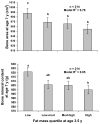Adiposity and TV viewing are related to less bone accrual in young children
- PMID: 18692201
- PMCID: PMC2646897
- DOI: 10.1016/j.jpeds.2008.06.031
Adiposity and TV viewing are related to less bone accrual in young children
Abstract
Objective: To examine the relation between baseline fat mass and gain in bone area and bone mass in preschoolers studied prospectively for 4 years, with a focus on the role of physical activity and TV viewing.
Study design: Children were part of a longitudinal study in which measures of fat, lean and bone mass, height, weight, activity, and diet were taken every 4 months from ages 3 to 7 years. Activity was measured by accelerometer and TV viewing by parent checklist. We included 214 children with total body dual energy x-ray absorptiometry (Hologic 4500A) scans at ages 3.5 and 7 years.
Results: Higher baseline fat mass was associated with smaller increases in bone area and bone mass over the next 3.5 years (P < .001). More TV viewing was related to smaller gains in bone area and bone mass accounting for race, sex, and height. Activity by accelerometer was not associated with bone gains.
Conclusions: Adiposity and TV viewing are related to less bone accrual in preschoolers.
Figures



Comment in
-
Fat, muscle, bone, and television.J Pediatr. 2009 Jan;154(1):A1. doi: 10.1016/j.jpeds.2008.11.016. J Pediatr. 2009. PMID: 19187716 No abstract available.
References
-
- Ogden CL, Carroll MD, Curtin LR, McDowell MA, Tabak CJ, Flegal KM. Prevalence of overweight and obesity in the United States, 1999-2004. JAMA. 2006;295:1549–55. - PubMed
-
- Frost HM. On our age-related bone loss: insights from a new paradigm. J Bone Miner Res. 1997;12:1539–46. - PubMed
-
- Arabi A, Tamim H, Nabulsi M, Maalouf J, Khalife H, Choucair M, et al. Sex differences in the effect of body-composition variables on bone mass in healthy children and adolescents. Am J Clin Nutr. 2004;80:1428–35. - PubMed
-
- Garnett SP, Hogler W, Blades B, Baur LA, Peat J, Lee J, et al. Relation between hormones and body composition, including bone, in prepubertal children. Am J Clin Nutr. 2004;80:966–72. - PubMed
Publication types
MeSH terms
Grants and funding
LinkOut - more resources
Full Text Sources
Medical

